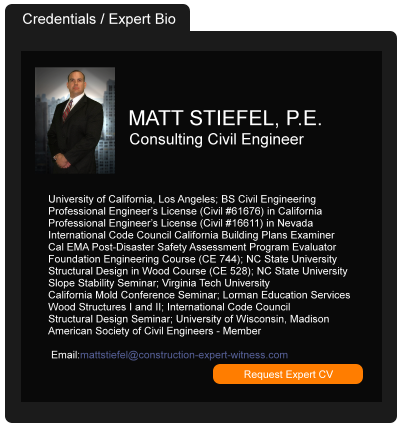New York Shuts Down Majority of Construction
March 30, 2020 —
Laura Bourgeois LoBue & Matthew D. Stockwell - Gravel2Gavel Construction & Real Estate Law BlogDue to pressure from construction workers, officials, and some construction workers having tested positive for COVID-19, the Empire State Development Corp. (acting on behalf of Governor Cuomo) has frozen all construction in New York today, with the exception of work on hospitals and health care facilities, transit facilities, roads and bridges, affordable housing and homeless shelters.
As a result, commercial construction and condominium projects are on hold, with the exception of work that must be completed to prevent unsafe conditions. Until now, construction has been considered “essential” in New York.
Reprinted courtesy of
Laura Bourgeois LoBue, Pillsbury and
Matthew D. Stockwell, Pillsbury
Ms. LoBue may be contacted at laura.lobue@pillsburylaw.com
Mr. Stockwell may be contacted at matthew.stockwell@pillsburylaw.com
Read the court decisionRead the full story...Reprinted courtesy of
Don’t Forget to Mediate the Small Stuff
August 02, 2017 —
Christopher G. Hill - Construction Law MusingsIt’s been a while since I talked mediation here at Construction Law Musings. Those that read regularly (thanks) have likely missed my musings on the topic. Those who read this construction blog regularly also know that I am both a Virginia Supreme Court certified general district court mediator and a huge advocate of mediation as a method to resolve construction disputes. While many of us think of mediation as a method to resolve the major disputes or litigation that occasionally rear their heads in the course of running a construction law practice or construction business, my experience as both a construction attorney and a mediator has taught me something: mediation works for all sizes of cases.
As an advocate for my construction clients, I know that proper trial preparation requires the same diligence and attention to detail for a smaller case as it does for a larger case. While a smaller case in the Virginia general district court may not have the depositions, written discovery and motions practice that a Virginia circuit court case may have, it still requires witness preparation, document processing and review and many of the other aspects of a larger case. While construction litigation is never a money maker in the best of circumstances, in the smaller cases the attorney fees often total a larger percentage of the total potential recovery. For this reason, the small cases are almost better suited for a quick mediated resolution than the larger ones. The larger cases may cost more to prosecute or defend, but the fees are less likely to eat up such a large percentage of any recovery.
Read the court decisionRead the full story...Reprinted courtesy of
Christopher G. Hill, The Law Office of Christopher G. HillMr. Hill may be contacted at
chrisghill@constructionlawva.com
Hydrogen Powers Its Way from Proof of Concept to Reality in Real Estate
May 10, 2021 —
Victoria Judd, Sidney L. Fowler & Robert G. Howard - Gravel2Gavel Construction & Real Estate Law BlogHydrogen is the new buzzword in every industry, and real estate is no exception. Hydrogen does not emit carbon dioxide when burnt and could therefore help reduce the climate impact of buildings, which in aggregate represent one of the biggest emitters of greenhouse gases after industry and surface transport. To the extent that hydrogen is to become an important power source globally, it will need to enter the domestic power market. The first step appears to be the development of pilot villages.
In the UK, there are several hydrogen trials in uninhabited properties or in closed private networks. There are some uninhabited houses on a Royal Air Force base in Cumbria that are exclusively heated with hydrogen and also a private gas network at Keele University which uses 20 percent hydrogen blended with natural gas. In addition, there is a small village near Newcastle that is being used as a test case: for a period of 10 months starting in spring 2021, up to 20 percent hydrogen will be blended into the natural gas network so that more than 650 homes can be partially heated by hydrogen. It is expected that a small number of additional villages will be able to heat their homes with 100 percent hydrogen as soon as 2022, with a scale up to have a hydrogen town by 2030.
Reprinted courtesy of
Victoria Judd, Pillsbury,
Sidney L. Fowler, Pillsbury and
Robert G. Howard, Pillsbury
Ms. Judd may be contacted at victoria.judd@pillsburylaw.com
Mr. Fowler may be contacted at sidney.fowler@pillsburylaw.com
Mr. Howard may be contacted at robert.howard@pillsburylaw.com
Read the court decisionRead the full story...Reprinted courtesy of
A Guide to California’s Changes to Civil Discovery Rules
April 29, 2024 —
Lewis Brisbois NewsroomSan Diego, Calif. (April 10, 2024) - California legislators have changed the rules of discovery in civil cases through the passage of amendments to Code of Civil Procedure sections 2016.090 and 2023.050, effective January 1, 2024.
Section 2016.090 creates a new set of rules for civil litigators in cases filed on or after January 1, 2024, which permits any party to the litigation to demand initial disclosures be provided within 60-days. Such a demand can be made any time after a party has filed a responsive pleading, including a demurrer or motion to strike.
Notably, this rule requires production of all information relevant to any causes of action that are pled at the time of the demand, meaning the parties may be required to disclose information related to claims that are being challenged on demurrer or a motion to strike, such as claims for punitive damages. This statute is only implicated when one of the parties to the action makes a demand and may be modified by stipulation of the parties.
Read the court decisionRead the full story...Reprinted courtesy of
Lewis Brisbois
Traub Lieberman Elects New Partners for 2020
February 24, 2020 —
Traub LiebermanTraub Lieberman is pleased to announce that
Adam P. Joffe and
Heather Fleming have been elected to the partnership effective January 1, 2020.
“Heather and Adam are terrific additions to our partnership and team. They are both effective, experienced and driven lawyers who work steadfastly on behalf of clients to meet their needs,” said Michael Knippen, firm chair.
Adam joined the firm in 2019 and is based in the firm’s Chicago office, which now includes 10 partners. He counsels and represents insurers in complex first-party and third-party coverage litigation. Adam also advises insurers on their coverage obligations under primary and excess commercial lines policies, including commercial general liability, employment practices liability, professional liability, and commercial property policies.
Read the court decisionRead the full story...Reprinted courtesy of
Traub Lieberman
Canada Home Resales Post First Fall in Eight Months
October 15, 2014 —
Greg Quinn – BloombergCanadian existing home sales fell from a four-year high in September (TNBHICY%), the first decline in eight months, led by Calgary and Edmonton in oil-rich Alberta.
Sales fell 1.4 percent to 41,666 units, the Canadian Real Estate Association said today from Ottawa. From a year earlier sales rose 10.6 percent and the average price climbed 5.9 percent to C$408,795 ($362,100).
The decline came in part because of a shortage of “affordably priced single family homes,” Beth Crosbie, CREA President, said in the report.
Read the court decisionRead the full story...Reprinted courtesy of
Greg Quinn, BloombergMr. Quinn may be contacted at
gquinn1@bloomberg.net
Address 'Your Work' Exposure Within CPrL Policies With Faulty Workmanship Coverage
December 29, 2020 —
Joseph Reynolds - Construction ExecutiveNew faulty workmanship coverage forms have emerged to potentially address the “your work” exposure found in most contractors professional liability (CPrL) policies. Once offered by only a single carrier, several insurers have recently entered the marketplace to cover the cost to repair or replace faulty work or the related material costs associated with the “self-performed work” of general and trade contractors.
Commonly serving as a separate insuring agreement and offered in carrier-specific CPrL policies, faulty workmanship coverage forms are designed to protect contractors from the “your work” claims triggered by project owners and other third parties. This includes the contractor’s workmanship as well as the equipment, parts and materials such as steel beams, epoxy activators and anchor bolts used to perform construction work.
Insureds should be aware that exclusions and strict conditions apply. For instance, faulty workmanship policies typically do not cover resulting bodily injury and property damage and some policies even exclude project delays and other business risks that can arise from the claims of unhappy customers. Another potentially confusing issue is the scope of coverage offered under a ‘faulty work’ endorsement. While some faulty workmanship enhancements are specifically-designed to cover “your work,” claims, others may only cover the products manufactured or fabricated by the insured and not the work they perform or install.
Reprinted courtesy of
Joseph Reynolds, Construction Executive, a publication of Associated Builders and Contractors. All rights reserved.
Read the court decisionRead the full story...Reprinted courtesy of
Mr. Reynolds may be contacted at
joseph.reynolds@rtspecialty.com
A Court-Side Seat: NWP 12 and the Dakota Access Pipeline Easement Get Forced Vacations, while a Potential Violation of the Eighth Amendment Isn’t Going Anywhere
August 10, 2020 —
Anthony B. Cavender - Gravel2GavelHere’s a report on several new decisions made over the past few days.
U.S. SUPREME COURT
U.S. Army Corps of Engineers v. Northern Plains Resources Council
On July 8, 2020, the Court has issued a partial stay of the decision of the U.S. District Court for Montana, which had held that the nationwide use by the Corps of Engineers of its Nationwide Permit 12 to permit oil and gas pipelines must be vacated because the Corps, when it reissued these permits in 2012, failed to follow the requirements of the Endangered Species Act. The breadth of this ruling seems to have surprised and alarmed many past and perspective permittees of the Corps. The stay will not apply to the ongoing Ninth Circuit litigation.
FEDERAL COURTS OF APPEAL
Vega, et al. v. Semple (The U.S. Court of Appeals for the Second Circuit)
On June 29, 2020, the court refused to dismiss a putative class action by past and present inmates of Connecticut’s Garner Correctional Institution who alleged that state correctional officials exposed them to excessive amounts of radon gas in violation of the Eighth Amendment. These officials are alleged to have been “deliberately indifferent” to inmate safety. A 1993 Supreme Court decision, Helling v. McKiney, clearly established the law in this area, and the Garner facility opened in 1992. The defense clams of limited immunity as to federal law violations were rejected.
Read the court decisionRead the full story...Reprinted courtesy of
Anthony B. Cavender, PillsburyMr. Cavender may be contacted at
anthony.cavender@pillsburylaw.com

































































